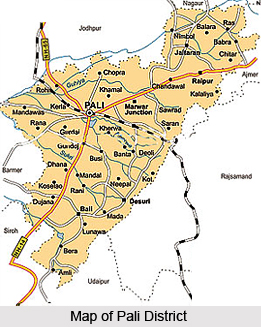 The State government has divided the Pali district in Six subdivisions viz. Pali, Bali, Sojat, Desuri, Sumerpur and Jaitaran. Each Sub-Division is looked after by the Sub-divisional Officer/Magistrate under the Collector and District Magistrate, Pali.. One Additional District Magistrate is also present to execute all the work. The District comprises of 9 tehsils as follows: Pali, Bali, Sumerpur, Rohit, Sojar, Marwar Junction, Jaitaran, Raipur and Desuri. A tehsil contains a number of Patwar-Mandals, each of which has a Patwari to serve the landholders and farmers at the village level. There are ten Panchayat Samitis (Blocks) in the District which are further divided into 320 Gram Panchayats (Primary Rural Local Bodies). Each block has a BDO (Block Development Officer) to serve as the representative of district administration in the rural areas.
The State government has divided the Pali district in Six subdivisions viz. Pali, Bali, Sojat, Desuri, Sumerpur and Jaitaran. Each Sub-Division is looked after by the Sub-divisional Officer/Magistrate under the Collector and District Magistrate, Pali.. One Additional District Magistrate is also present to execute all the work. The District comprises of 9 tehsils as follows: Pali, Bali, Sumerpur, Rohit, Sojar, Marwar Junction, Jaitaran, Raipur and Desuri. A tehsil contains a number of Patwar-Mandals, each of which has a Patwari to serve the landholders and farmers at the village level. There are ten Panchayat Samitis (Blocks) in the District which are further divided into 320 Gram Panchayats (Primary Rural Local Bodies). Each block has a BDO (Block Development Officer) to serve as the representative of district administration in the rural areas.
The working of the Panchayat Samiti and Gram Panchayats is coordinated and administered by the Zila Parishad (District Council) consisting of 33 Members. Various development works and projects at the rural level (Gram Panchayat Level) are run through Block offices. One Gram Sevak is appointed at each Gram Panchayat to keep record of the development works and to project required development works.
The District is represented in the State Legislature by eight MLAs. One Member of Parliament is also elected by the public.
Rural Developmental Project
Rural India, which accounts for nearly three fourths of India`s population, is characterized by low income levels which are inadequate to ensure a quality of life compatible with the physical well being of the common man. District Administration, in accordance with the policies of the Central and State governments, is responsible at the grassroots for launching a frontal attack on rural poverty through various programmes which endeavour to reach out to the last and most disadvantaged sections of society, provide them with avenues of employment and to improve infrastructure relating to their life-supporting systems. Rural Development and poverty alleviation programmes are implemented on a decentralized basis throughout the country. The Central Government Ministry of Rural Development has been implementing programmes in the rural areas for which it releases central share of funds for policy formulation, overall guidance, monitoring and evaluation of the rural development programmes.
At the state level, Secretary, Rural Development of the State Govt. is the overall in charge for implementation. The department also formulates new rural development plans as per the policy of the state government
At the district level the District Rural Development Agency (DRDA) / Zila Parishad are responsible for the implementation of the rural development programs. The governing body of the D.R.D.A. includes the Members of Parliament (MPs), Members of Legislative Assembly (MLAs), district level officials of related departments, and representatives of the weaker sections of the society.
At the block level the Block Development Officer and at the village level, the Gram Sevaks (Village Representatives) are responsible for the implementation of rural development plans.
Various Rural development program of the Center as well as State governments are Jawahar Gram Samridhi Yojana, MLA Local Area Development Program, Indira Awaas Yojana( New and Upgradation), Swarna Jayanti Swarojgaar Yojana, Pradhaan Mantri Gramodaya Yojana ( New and Upgrdation), Awasiya Rin / Anudaan Yojana, Uup Swasthya Kendra Yojana, Sampoorana Gramin Swarojgar Yojna, 32-Zila 32-Kaam Yojana, Grameen Vikaas Kendra Yojana, MADA Scheme and the Kaam ke Badle Anaaj Yojana etc.



















